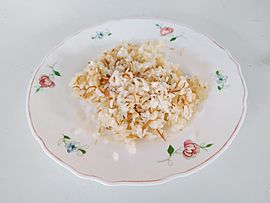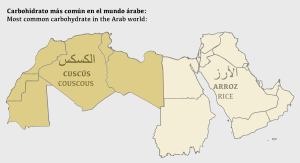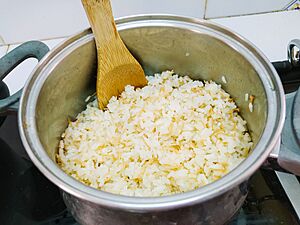Arabic rice facts for kids
 |
|
| Alternative names | Lebanese rice, Egyptian-style rice |
|---|---|
| Type | staple dish |
| Associated national cuisine | Arabic cuisine |
| Main ingredients | rice and vermicelli |
| Ingredients generally used | clarified butter or olive oil, salt, water |
Arabic rice or rice with vermicelli is a popular dish from the Middle East. It's a special way of cooking rice that includes small, thin noodles called vermicelli. These noodles are lightly toasted before being cooked with the rice.
This cooking style is often called pilaf. It makes the rice light and fluffy, so the grains don't stick together. People usually use long-grain rice like basmati or jasmine. But you can also use short-grain rice, like misri (Egyptian rice), or even Brown rice.
The vermicelli used in this dish are very fine noodles. In Turkey, they are called şehriye. In Arab countries, they are known as shariyah. For cooking, people often use clarified butter, which is called samneh in Arabic or ghee internationally. If that's not available, regular butter or olive oil works too. Sometimes, other ingredients are added, like raisins, pine nuts, garlic, onion, or almonds. These additions depend on the region or even the family making the dish.
When people from Arab countries moved to the Americas, they brought this delicious rice recipe with them. Today, it's a common dish in some parts of Hispanic America, especially around Christmas. You can find arroz árabe or arroz con fideos in the traditional food of Colombia, the Dominican Republic, Peru, and Chile.
What is Arabic Rice?

In the Arab world, this way of cooking rice is so common that it's just called "rice." It's a main part of most meals in the Middle East. This includes countries like Egypt, Lebanon, Syria, and Saudi Arabia.
However, it's different in North Africa, which is called the Maghreb. Countries like Morocco and Algeria mostly eat couscous, which is made from wheat. While rice is known there, it's not as common. The same goes for couscous in the Middle East; it's known but not a main dish.
This dish is also very popular in Turkish cuisine, where it's known as şehriyeli pilavı. Sometimes, you might hear it called "Lebanese rice" or "Egyptian-style rice" in other countries. All these names refer to the same tasty dish.
How to Make Arabic Rice
Making Arabic rice involves a few simple steps. Recipes might vary a little, but the basic idea is the same.
First, the rice is rinsed under running water until the water is clear. This helps remove extra starch. Sometimes, it's left to soak. In the past, people washed rice to remove small stones or dust. Today, rice is usually clean, so this step is not always strictly needed.
Next, you heat olive oil or clarified butter in a pan. Then, you add the vermicelli noodles. They are very thin, so they will turn golden brown in just a few minutes. It's important to watch them closely so they don't burn.
Once the vermicelli are golden, add the rinsed rice to the pan. Stir the rice so that it gets coated with the oil or butter. This helps prevent the rice from sticking together later. At this point, you also add salt and any other spices you like.
A few minutes later, you add water or chicken broth. The general rule is to use the same amount of liquid as rice. For example, if you use one cup of rice, use one cup of water. Cover the pan, and once the water starts to boil, lower the heat. The rice will cook for about 15 to 30 minutes, depending on how high up you are (altitude).
If you use short-grain rice, it might stick together more. So, it's a good idea to add a little more oil or butter after it finishes cooking. This helps keep it fluffy.
See also
 In Spanish: Arroz árabe para niños
In Spanish: Arroz árabe para niños


